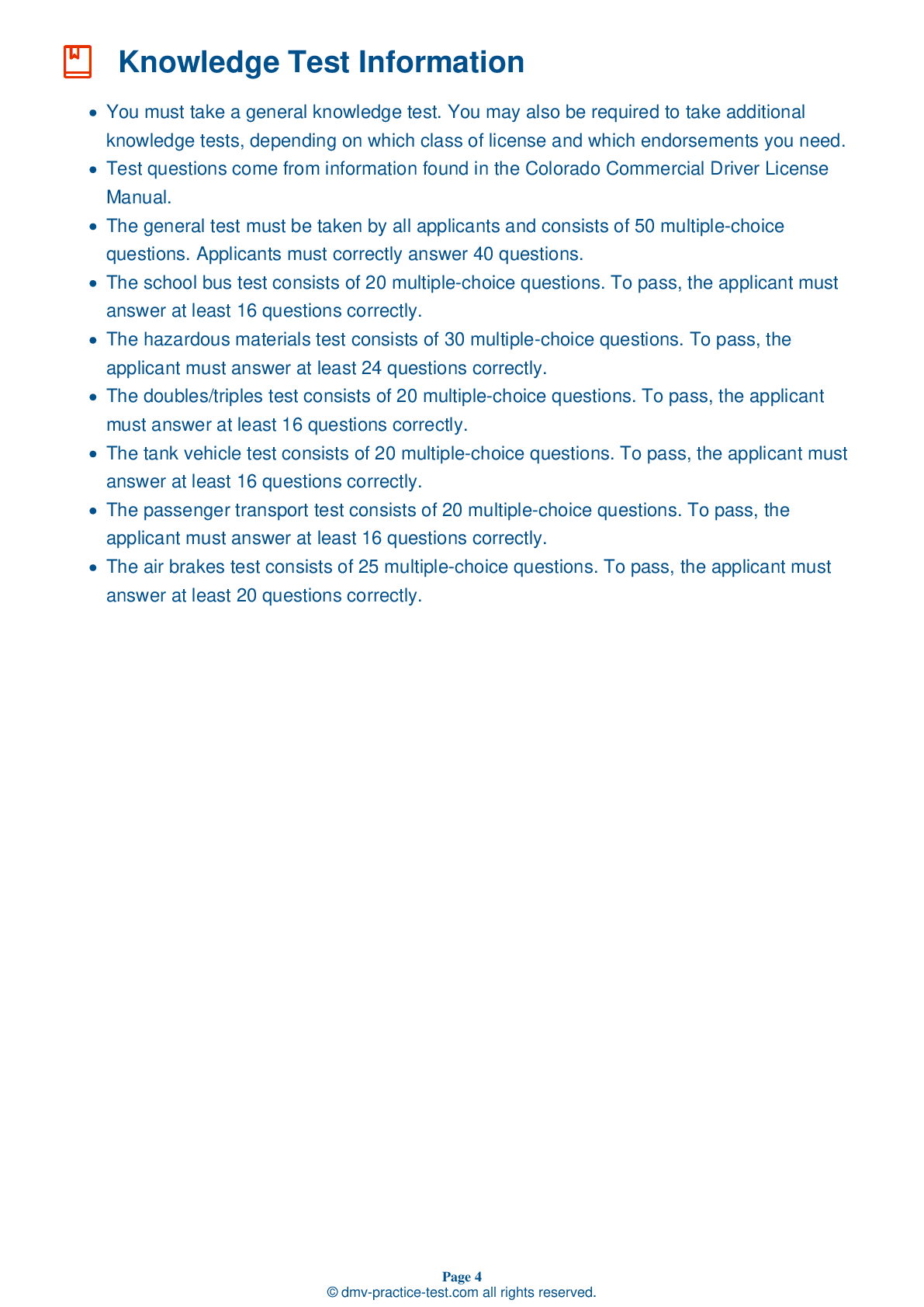Combination #1
Combination Vehicles Practice Test | Colorado 2025 #1 Page 3 of 3
Train for FREE online with our Colorado CDL combination vehicle test. The official exam test consists of several obligatory parts, with all of them checking your knowledge of different blocks of road rules. If you need to obtain a CO combination license in 2025, practice as much as possible. Free sample tests published on our website will help you check and improve your knowledge and boost your grades. Please bear in mind that DMV requirements for issuing a combination license may vary from state to state.
20
16
20
15 . A shut-off valve:
Should always be open.
Shut-off valves are used in air supply lines to control the passage of air from one trailer to another. The rear shut-off valve should always be closed to prevent air from leaving the braking system.
16 . After coupling, there should be ____ between the upper and lower fifth wheel.
Three inches of space
Before a trip, be sure to inspect all couplings. There should be no space between the upper and lower fifth wheel.
17 . Driving a combination vehicle ____ than driving a single vehicle.
Is safer in inclement weather
Driving a combination vehicle usually requires more skill than driving a single vehicle. Combination vehicles are generally longer and heavier than single commercial vehicles.
18 . In a vehicle equipped with an automatic tractor protection valve, the valve will pop out when:
Air pressure is above 45 psi.
In vehicles equipped with an automatic tractor protection valve, the valve will pop out if air pressure drops to a level between 20 and 45 psi. When the valve pops out, the protection valve will close, stopping the flow of air.
19 . Push in the trailer air supply control to:
Supply the trailer with air.
Push in the trailer air supply control to supply the trailer with air. Pull out the trailer air supply control to turn off the air supply and activate the emergency brakes.
20 . When traveling more slowly than 40 mph, maintain at least ____ of following distance per every 10 feet of your vehicle.
Four seconds
At speeds below 40 mph, you should allow at least one second of following distance for every 10 feet of your vehicle. Follow the same formula when traveling at faster speeds, then add one additional second to your following distance. Remember that larger vehicles require more space to stop than smaller vehicles.
2025 Colorado | Frequently Asked Questions
A CDL Class B license in Colorado allows the holder to operate single vehicles with a gross vehicle weight rating (GVWR) of 26,001 pounds or more, or towing vehicles not exceeding 10,000 pounds GVWR. This includes buses, farm labor vehicles, and any vehicle designed to transport 16 or more passengers including the driver.
A Class B CDL license in Colorado allows the holder to operate single vehicles with a gross vehicle weight rating of 26,001 pounds or more, and towed vehicles not exceeding 10,000 pounds. It covers vehicles like city buses, delivery trucks, dump trucks with small trailers, and large straight trucks.
To acquire a Class B CDL license in Colorado, you must be at least 18 years old (21 for interstate driving), possess a valid Colorado driver's license, pass a vision test, and successfully complete a written knowledge test. Additionally, you must pass a skills test which includes a pre-trip vehicle inspection, basic vehicle control, and on-road driving.
In Colorado, you must be at least 18 years old to qualify for a Class B Commercial Driver's License (CDL) for intrastate driving (within Colorado only). However, you must be at least 21 years old to drive a commercial vehicle across state lines, carry hazardous materials, or transport passengers.
Specific endorsements aren't necessary for a Class B CDL license but they can broaden your driving capabilities. Endorsements include: H for hazardous materials, N for tank vehicles, P for passenger vehicles, S for school buses, and T for double/triple trailers. Each endorsement requires passing a knowledge test and some require a skills test.
The Class B CDL skills assessment in Colorado includes three parts: a pre-trip vehicle inspection, a basic vehicle control test, and an on-road driving test. You must demonstrate knowledge of your vehicle and its controls, show ability to manage its operation under various traffic conditions, and ensure it's safe for the road.
Yes, Class B CDL license holders in Colorado are restricted to operating vehicles with a GVWR of 26,001 or more pounds, or towing vehicles not more than 10,000 pounds. They can also operate buses with 24 passengers or more, including the driver. However, they cannot operate Class A vehicles unless they have the appropriate endorsements.
In Colorado, the written CDL test is offered only in English. Federal regulations mandate that all CDL applicants demonstrate proficiency in English. They must be able to read, write, speak, and understand the language to converse with the general public, understand highway traffic signs and signals, respond to official inquiries, and make entries on reports and records.
Yes, you can request accommodations for the Class B CDL written exam in Colorado if you have a disability. You must provide documentation of your disability and specify the type of accommodation needed. The DMV is committed to providing equal access to its services and will make reasonable accommodations in accordance with the Americans with Disabilities Act.
Yes, you can retake the Class B CDL written test in Colorado. If you fail, you must wait one day before retaking it. If you fail three times, you must wait 30 days before your next attempt. Keep in mind each retest has an associated fee and make sure to study the manual thoroughly before retaking the test.



